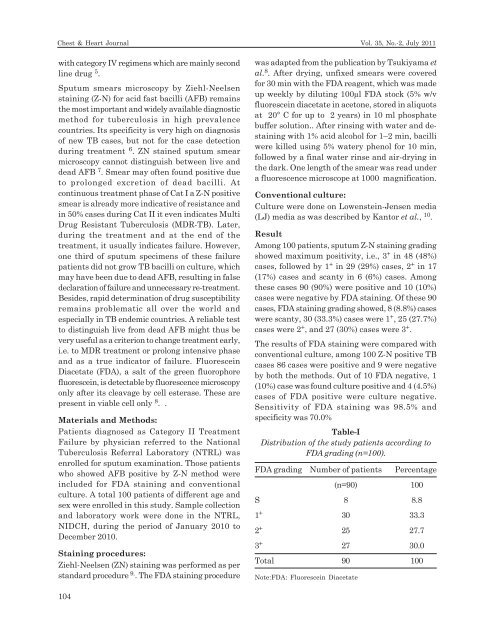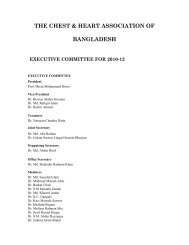Volume. 35, No. 2 july. 2011 - The Chest and Heart Association of ...
Volume. 35, No. 2 july. 2011 - The Chest and Heart Association of ...
Volume. 35, No. 2 july. 2011 - The Chest and Heart Association of ...
Create successful ePaper yourself
Turn your PDF publications into a flip-book with our unique Google optimized e-Paper software.
<strong>Chest</strong> & <strong>Heart</strong> Journal Vol. <strong>35</strong>, <strong>No</strong>.-2, July <strong>2011</strong>with category IV regimens which are mainly secondline drug 5 .Sputum smears microscopy by Ziehl-Neelsenstaining (Z-N) for acid fast bacilli (AFB) remainsthe most important <strong>and</strong> widely available diagnosticmethod for tuberculosis in high prevalencecountries. Its specificity is very high on diagnosis<strong>of</strong> new TB cases, but not for the case detectionduring treatment 6 . ZN stained sputum smearmicroscopy cannot distinguish between live <strong>and</strong>dead AFB 7 . Smear may <strong>of</strong>ten found positive dueto prolonged excretion <strong>of</strong> dead bacilli. Atcontinuous treatment phase <strong>of</strong> Cat I a Z-N positivesmear is already more indicative <strong>of</strong> resistance <strong>and</strong>in 50% cases during Cat II it even indicates MultiDrug Resistant Tuberculosis (MDR-TB). Later,during the treatment <strong>and</strong> at the end <strong>of</strong> thetreatment, it usually indicates failure. However,one third <strong>of</strong> sputum specimens <strong>of</strong> these failurepatients did not grow TB bacilli on culture, whichmay have been due to dead AFB, resulting in falsedeclaration <strong>of</strong> failure <strong>and</strong> unnecessary re-treatment.Besides, rapid determination <strong>of</strong> drug susceptibilityremains problematic all over the world <strong>and</strong>especially in TB endemic countries. A reliable testto distinguish live from dead AFB might thus bevery useful as a criterion to change treatment early,i.e. to MDR treatment or prolong intensive phase<strong>and</strong> as a true indicator <strong>of</strong> failure. FluoresceinDiacetate (FDA), a salt <strong>of</strong> the green fluorophorefluorescein, is detectable by fluorescence microscopyonly after its cleavage by cell esterase. <strong>The</strong>se arepresent in viable cell only 8 . .Materials <strong>and</strong> Methods:Patients diagnosed as Category II TreatmentFailure by physician referred to the NationalTuberculosis Referral Laboratory (NTRL) wasenrolled for sputum examination. Those patientswho showed AFB positive by Z-N method wereincluded for FDA staining <strong>and</strong> conventionalculture. A total 100 patients <strong>of</strong> different age <strong>and</strong>sex were enrolled in this study. Sample collection<strong>and</strong> laboratory work were done in the NTRL,NIDCH, during the period <strong>of</strong> January 2010 toDecember 2010.Staining procedures:Ziehl-Neelsen (ZN) staining was performed as perst<strong>and</strong>ard procedure 9. . <strong>The</strong> FDA staining procedurewas adapted from the publication by Tsukiyama etal. 8 . After drying, unfixed smears were coveredfor 30 min with the FDA reagent, which was madeup weekly by diluting 100µl FDA stock (5% w/vfluorescein diacetate in acetone, stored in aliquotsat 20° C for up to 2 years) in 10 ml phosphatebuffer solution.. After rinsing with water <strong>and</strong> destainingwith 1% acid alcohol for 1–2 min, bacilliwere killed using 5% watery phenol for 10 min,followed by a final water rinse <strong>and</strong> air-drying inthe dark. One length <strong>of</strong> the smear was read undera fluorescence microscope at 1000 magnification.Conventional culture:Culture were done on Lowenstein-Jensen media(LJ) media as was described by Kantor et al., 10 .ResultAmong 100 patients, sputum Z-N staining gradingshowed maximum positivity, i.e., 3 + in 48 (48%)cases, followed by 1 + in 29 (29%) cases, 2 + in 17(17%) cases <strong>and</strong> scanty in 6 (6%) cases. Amongthese cases 90 (90%) were positive <strong>and</strong> 10 (10%)cases were negative by FDA staining. Of these 90cases, FDA staining grading showed, 8 (8.8%) caseswere scanty, 30 (33.3%) cases were 1 + , 25 (27.7%)cases were 2 + , <strong>and</strong> 27 (30%) cases were 3 + .<strong>The</strong> results <strong>of</strong> FDA staining were compared withconventional culture, among 100 Z-N positive TBcases 86 cases were positive <strong>and</strong> 9 were negativeby both the methods. Out <strong>of</strong> 10 FDA negative, 1(10%) case was found culture positive <strong>and</strong> 4 (4.5%)cases <strong>of</strong> FDA positive were culture negative.Sensitivity <strong>of</strong> FDA staining was 98.5% <strong>and</strong>specificity was 70.0%Table-IDistribution <strong>of</strong> the study patients according toFDA grading (n=100).FDA grading Number <strong>of</strong> patients Percentage(n=90) 100S 8 8.81 + 30 33.32 + 25 27.73 + 27 30.0Total 90 100<strong>No</strong>te:FDA: Fluorescein Diacetate104



